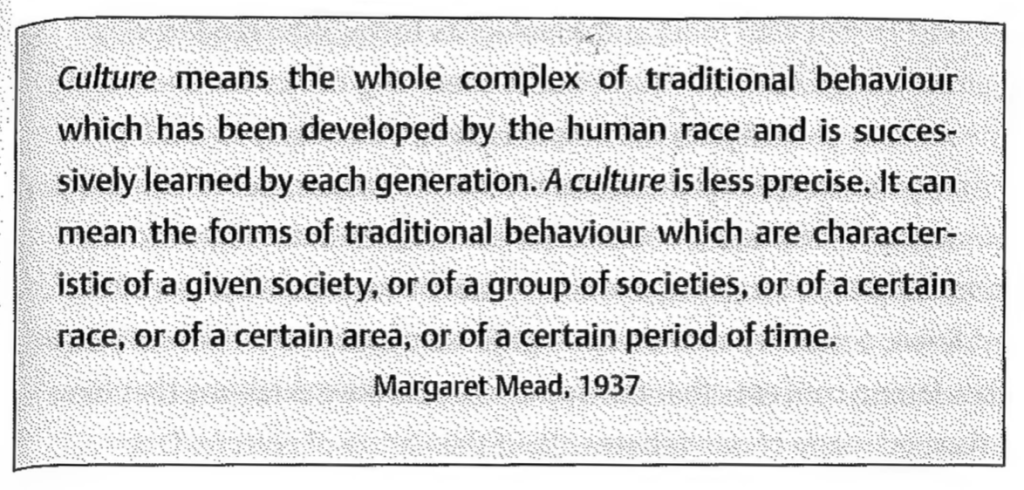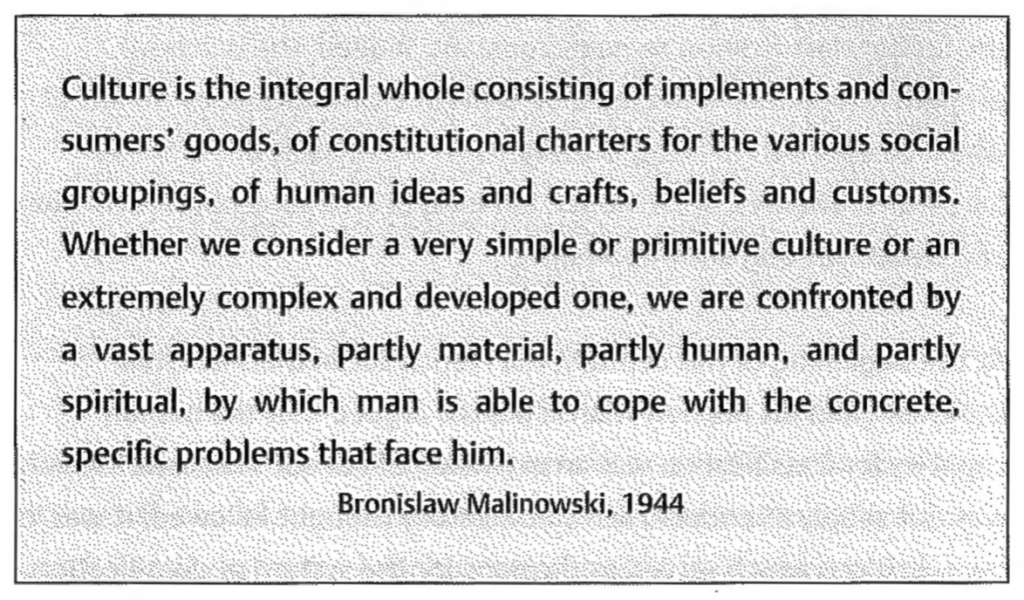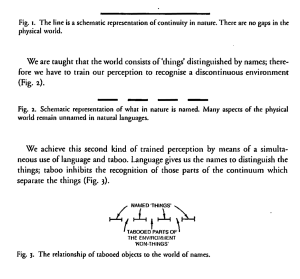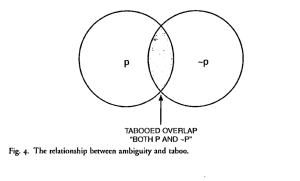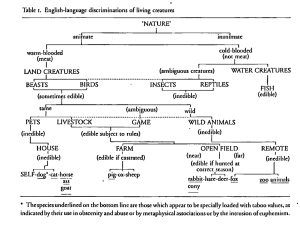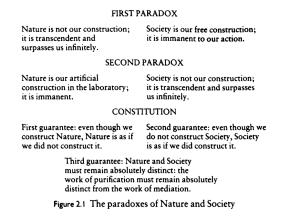Bee Larvae and Onion Soup: Culture
by John Monaghan & Peter Just
[Monaghan, John and Just, Peter. 2000. “Bee Larvae and Onion Soup: Culture.” in Social and Cultural Anthropology: A Very Short Introduction. Pp. 34-52.]
Points & Quotes:
Universalized “culture”
“one learns a great deal that one is never explicitly taught.” (36)
“Boas described a human a kulturbrille, a set of ‘cultural glasses’ that each of us wears, lenses that provide us with a means of perceiving the world around us, for interpreting the meaning of our social lives, and framing action in them.” (38)
“At least three points of debate have continued to recur in the way anthropologists talk about the concept of culture.
-
- One has to do with the extent to which a ‘culture’ should be regarded as an integrated whole;
- the second has to do with the extent to which ‘culture’ can be seen as an autonomous, ‘superorganic’ entity;
- and the third has to do with how we can best go about drawing boundaries around ‘cultures’.” (43-44, formatting added)
To Durkheim and Mauss: “Society was not simply a model which classificatory thought followed; it was its own divisions which served as divisions for the system of classification.” (40-41)
“Claude Levi-Strauss, the founder of ‘structuralist’ anthropology, would claim that human classification is indeed universal,but that it is universal because a human predisposition to making distinctions produced classifications that mutatis mutandis were but surface representations of a more fundamental ‘deep structure’ shaped by the binary nature of the human mind.”
- “[l]f we look at all the intellectual undertakings of mankind … the common denominator is always to introduce some kind of order. If this represents a basic need for order in the human mind and since, after all, the human mind is onlypart of the universe, the need probably exists because there is some order in the universe and the universe is not chaos.” (41)
“French philosopher Michel Foucault has popularized a new direction among some anthropologists, who have come to see the categories of meaning imposed by culture as a basis of inequality and oppression. In other words, they see the ability to control the content of cultural classifications as a primary source of power in society. This in turn makes the contestation of categories of social classification, such as ‘male’ and ‘female’, with all of the social, political, and economic associations that attend them, a primary mode of resistance to authority. ” (42)
“The idea that culture is an integrated and integrating whole is in part based upon the great modernist insight that underlying apparently discrete bits of belief or behaviour rests a more fundamental reality. For Karl Marx that determining reality was the mode of production; for Emile Durkheim it was society; for Sigmund Freud it was the unconscious; and for many in anthropology, following the lead of Boas, it has been culture itself.” (43-44)
“Ruth Benedict, one of Boas’ first students, conceived of a culture as a Gestalt, a total pattern … Although Benedict’s approach is now regarded as too simplistic and reductionist, because of its tendency to view cultures in terms of one or two key themes, it has continued to prove a powerful means for organizing and integrating the minutiae of ethnographic observation.” (44)
Clifford Geertz “used cockfighting – a popular form of entertainment in Bali – as an image that also serves to characterize beliefs and practices … In this way, Geertz is able to show how disparate elements of Balinese culture create a ‘fabric of meaning and belief’ that is consistent and mutually reinforcing. For Geertz, cultures can be read as texts, much as one might read a novel or a poem. The trick, according to Geertz, is to seek out cultural ‘texts’ that the people of the society themselves find compelling – as the Balinese are fascinated by cockfighting – and to not only understand them as they see them, but to see the ways the themes of these ‘texts’ illuminate other aspects of the society.” (44-45)
Some “refer to cultures as if they were autonomous things with lives of their own. Alfred Kroeber once compared culture to a coral reef, which is built up by the secretions of millions of tiny animals, but which existed before any of its living members, and will outlast them all, providing a structure within which future generations will be constrained.” (46)
“Anthony Wallace argued that the contents of the individual mind are in fact highly divergent, and that what culture does is not so much impose a uniformity, but provide a set of shared communicative symbols that organizes this diversity.” (47)
“The essentialism attributed to culture found itself expressed in ethnographies that routinely assumed ‘one people, one culture, one society’. But, as Arjun Appadurai recently asked, doesn’t this premise fly in the face of ‘unequal knowledge and the differential prestige of lifestyles, and discourage attention to the world views and agency of those who are marginalized or dominated’? ” (47)
Big Point!
“Perhaps it would be best to join with most anthropologists today, who tend to view culture not as a thing in itself, but as a learning device for uncovering meaning in social life.” (47-48)
“the anthropological concept of culture has been our discipline’s most significant contribution to modern thought. In uncovering the fundamentally arbitrary and learned basis for the differences among and between human communities, the culture concept has been a powerful weapon in combating racism, national chauvinism, and the ‘scientific’ racism’ that characterized much of anthropology in the nineteenth century” (48)
Cultural Relativism (really good breakdown)
- We start from the premise that our beliefs, morals, behaviours – even our very perceptions of the world around us – are the products of culture, learned as members of the communities in which we are reared.
- If, as we believe, the content of culture is the product of the arbitrary, historical experience of a people, then what we are as social beings is also an arbitrary, historical product.
- Because culture so deeply and broadly determines our worldview, it stands to reason that we can have no objective basis for asserting that one such worldview is superior to another, or that one worldview can be used as a yardstick to measure another.
- In this sense, cultures can only be judged relative to one another, and the meaning of a given belief or behaviour must first and foremost be understood relative to its own cultural context.
- That, in a nutshell, is the basis of what has come to be called cultural relativism. (49, formatting added)
“In addition to these aspects of cultural relativism we must also entertain the moral dimensions of cultural relativism … Behaviour that might be nonsensical, illegal, or immoral in one society might be perfectly rational and socially accepted in another … do we deal with the stranger in our midst when that stranger’s culture is morally different from our own? At what point are segments of a given community entitled to a claim of cultural distinctiveness that demands autonomy and respect? Are soccer hooligans or terrorists entitled to claim the protection of cultural relativism?” (50-51)
“One wonders, ultimately, if it is logically possible to simultaneously subscribe to both the notion of universal human rights and a belief in the relativity of cultures.” (52)
“we note with Clifford Geertz that the crimes committed in the name of cultural relativism pale in comparison to those committed in the name of cultural and national chauvinism or, for that matter, almost any other ‘ism’. His stance is one of ‘anti-anti relativism.” (52)


